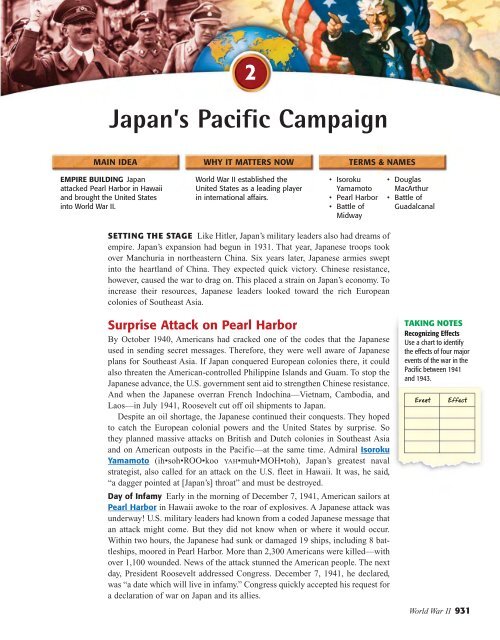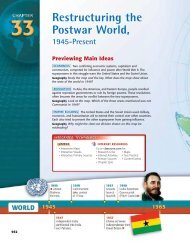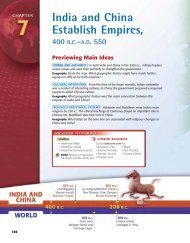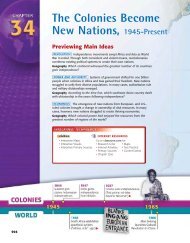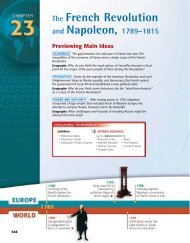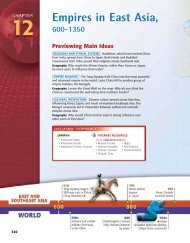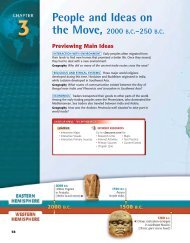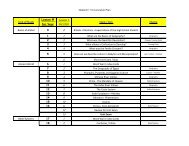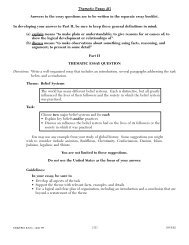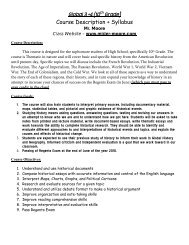World War II, 1939–1945 - Previewing Main Ideas - Mister Moore
World War II, 1939–1945 - Previewing Main Ideas - Mister Moore
World War II, 1939–1945 - Previewing Main Ideas - Mister Moore
Create successful ePaper yourself
Turn your PDF publications into a flip-book with our unique Google optimized e-Paper software.
MAIN IDEA WHY IT MATTERS NOW TERMS & NAMES<br />
EMPIRE BUILDING Japan<br />
attacked Pearl Harbor in Hawaii<br />
and brought the United States<br />
into <strong>World</strong> <strong>War</strong> <strong>II</strong>.<br />
2<br />
Japan’s Pacific Campaign<br />
<strong>World</strong> <strong>War</strong> <strong>II</strong> established the<br />
United States as a leading player<br />
in international affairs.<br />
• Isoroku<br />
Yamamoto<br />
• Pearl Harbor<br />
• Battle of<br />
Midway<br />
SETTING THE STAGE Like Hitler, Japan’s military leaders also had dreams of<br />
empire. Japan’s expansion had begun in 1931. That year, Japanese troops took<br />
over Manchuria in northeastern China. Six years later, Japanese armies swept<br />
into the heartland of China. They expected quick victory. Chinese resistance,<br />
however, caused the war to drag on. This placed a strain on Japan’s economy. To<br />
increase their resources, Japanese leaders looked toward the rich European<br />
colonies of Southeast Asia.<br />
Surprise Attack on Pearl Harbor<br />
By October 1940, Americans had cracked one of the codes that the Japanese<br />
used in sending secret messages. Therefore, they were well aware of Japanese<br />
plans for Southeast Asia. If Japan conquered European colonies there, it could<br />
also threaten the American-controlled Philippine Islands and Guam. To stop the<br />
Japanese advance, the U.S. government sent aid to strengthen Chinese resistance.<br />
And when the Japanese overran French Indochina—Vietnam, Cambodia, and<br />
Laos—in July 1941, Roosevelt cut off oil shipments to Japan.<br />
Despite an oil shortage, the Japanese continued their conquests. They hoped<br />
to catch the European colonial powers and the United States by surprise. So<br />
they planned massive attacks on British and Dutch colonies in Southeast Asia<br />
and on American outposts in the Pacific—at the same time. Admiral Isoroku<br />
Yamamoto (ih•soh•ROO•koo YAH•muh•MOH•toh), Japan’s greatest naval<br />
strategist, also called for an attack on the U.S. fleet in Hawaii. It was, he said,<br />
“a dagger pointed at [Japan’s] throat” and must be destroyed.<br />
Day of Infamy Early in the morning of December 7, 1941, American sailors at<br />
Pearl Harbor in Hawaii awoke to the roar of explosives. A Japanese attack was<br />
underway! U.S. military leaders had known from a coded Japanese message that<br />
an attack might come. But they did not know when or where it would occur.<br />
Within two hours, the Japanese had sunk or damaged 19 ships, including 8 battleships,<br />
moored in Pearl Harbor. More than 2,300 Americans were killed—with<br />
over 1,100 wounded. News of the attack stunned the American people. The next<br />
day, President Roosevelt addressed Congress. December 7, 1941, he declared,<br />
was “a date which will live in infamy.” Congress quickly accepted his request for<br />
a declaration of war on Japan and its allies.<br />
• Douglas<br />
MacArthur<br />
• Battle of<br />
Guadalcanal<br />
TAKING NOTES<br />
Recognizing Effects<br />
Use a chart to identify<br />
the effects of four major<br />
events of the war in the<br />
Pacific between 1941<br />
and 1943.<br />
Event Effect<br />
<strong>World</strong> <strong>War</strong> <strong>II</strong> 931


